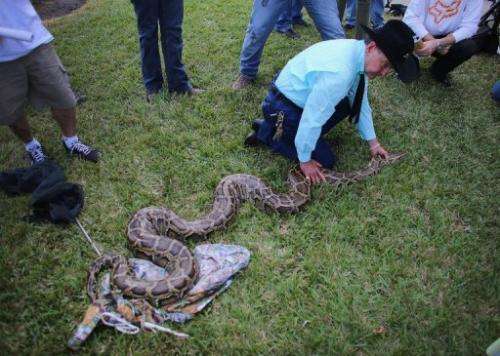Python hunt in Everglades nets just 68: organizers

Hundreds of hunters spent a month combing Florida's Everglades for Burmese pythons, in the end capturing and killing 68 of the slithery, invasive reptiles, organizers said.
The longest was 14 feet and three inches, netting the hunter who brought it in a $1,000 prize.
The Florida's Fish and Wildlife Conservation Commission also announced winners of two $1,500 prizes for the hunters who killed the most Burmese pythons, an invasive species seen as a threat to the wetlands' eco-system.
The total take was 68 Burmese pythons, said Nick Wiley, the FWC's executive director.
"In our view, that number was an unprecedented number of samples that would help us answer questions about pythons and make us more effective on removing them from the system," he said.

The first Burmese pythons in the Everglades are believed to have been household pets that escaped into the vast wetlands after Hurricane Andrew in 1992.
The snakes have rapidly reproduced since, and now outnumber native snakes. Excellent swimmers, they are also at home in trees.
Scientists say they have been behind the falling numbers of small mammals—like weasels, raccoons, rabbits and wild rats—in the Everglades.
"Every python taken out of the system is a great benefit, and we know that it takes a significant investment of time to capture one python. As it does for any kind of hunting, it's not always easy," Wiley said.
As part of the campaign to combat the snakes, the WCC this year launched its first "Python Challenge," a month-long hunt that ran from January 10 to February 10.
"We didn't know what the actual interest would be, if people would really come and participate in this. Well, we know now: we had more than 600 participants from 38 states and even had people who signed up from Canada," Wiley said.
Anyone over 18 was allowed to participate for a $25 registration fee, and they could use the weapon of their choice so long as the pythons were killed humanely.
The remains of the snakes are being sent to the University of Florida to be studied.
(c) 2013 AFP
















